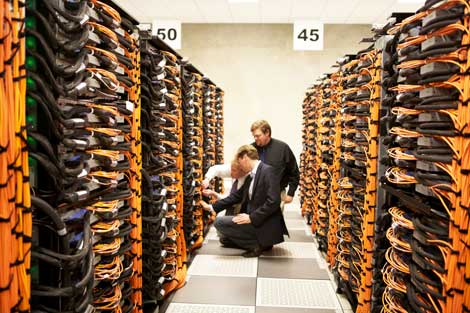
A look at the cabling supporting the Mira supercomputer in Argonne National Laboratory. Argonne is among the labs where the DOE hopes to seed "extreme scale" supercomputing. (Photo: ANL)
The federal government has awarded $62 million in contracts to advance "extreme scale" supercomputing, hoping to create machines that can deliver 1,000 times the performance of today's fastest computers.
The National Nuclear Security Administration (NNSA) announced the research and development contracts under a Department of Energy initiative called FastForward. Five companies in high performance computing are tasked with accelerating the development of next-generation supercomputers vital to national defense, scientific research, energy security, and the nation’s economic competitiveness.
Awards to advance “extreme scale” computing technology with the goal of funding innovative R&D of critical technologies were given to AMD, IBM, Intel, Nvidia and Whamcloud. To reach this 'extreme scale' the DOE requires exascale systems that operate at quintillions of floating point operations per second (exaflop), where top supercomputers today are performing at petaflops.
“The challenge is to deliver 1,000 times the performance of today’s computers with only a fraction more of the system’s energy consumption and space requirements,” said William Harrod, division director of research in DOE Office of Science’s Advanced Scientific Computing Research program.
FastForward Program
The FastForward program, funded by DOE’s Office of Science and NNSA, is managed by LLNL on behalf of seven national laboratories including: Lawrence Berkeley, Los Alamos, Sandia, Oak Ridge, Argonne and Pacific Northwest. Technical experts from the participating national laboratories evaluated and helped select the proposals and will work with selected vendors on co-design.
“Exascale computing will be required to fully assess the performance of our nation’s nuclear stockpile in all foreseeable situations without returning to nuclear testing,” said Bob Meisner, head of NNSA’s Advanced Simulation and Computing (ASC) program. “The insight that comes from simulations is also vital to addressing nonproliferation and counterterrorism issues, as well as informing other national security decisions.”
Under the contract awards, AMD is working on processors and memory for extreme systems, IBM is also working on memory for extreme systems, Intel Federal is working on energy efficient processors and memory architectures, Nvidia is working on processor architecture for exascale computing at low power and Whamcloud is leading a group working on storage and I/O.





